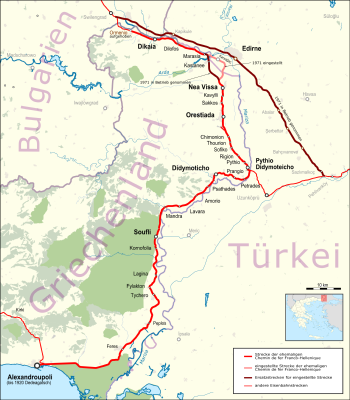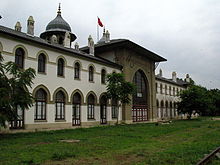Chemin de fer Franco-Hellenique
| Chemin de fer Franco-Hellenique | |||||||||||||||||||||||||||||||||||||||||||||||||||||||||||||||||
|---|---|---|---|---|---|---|---|---|---|---|---|---|---|---|---|---|---|---|---|---|---|---|---|---|---|---|---|---|---|---|---|---|---|---|---|---|---|---|---|---|---|---|---|---|---|---|---|---|---|---|---|---|---|---|---|---|---|---|---|---|---|---|---|---|---|
|
Locomotive 102 of the CFFH 1953 in Alexandroupoli
| |||||||||||||||||||||||||||||||||||||||||||||||||||||||||||||||||
|
Route network of the former CFFH (as of 2015)
| |||||||||||||||||||||||||||||||||||||||||||||||||||||||||||||||||
| Route length: | 173 km | ||||||||||||||||||||||||||||||||||||||||||||||||||||||||||||||||
| Gauge : | 1435 mm ( standard gauge ) | ||||||||||||||||||||||||||||||||||||||||||||||||||||||||||||||||
|
|||||||||||||||||||||||||||||||||||||||||||||||||||||||||||||||||
The Chemin de fer Franco-Hellenique (CFFH, full name Companie franco-hellenique des chemins de fer , in Greek Γαλλοελληνική Εταιρεία Σιδηροδρόμων (ΓΕΣ)) was a private railway company in Greece and Turkey that existed from 1929 to 1955 .
history
After the First World War and the subsequent Greco-Turkish War from 1919 to 1922, a provisional solution to the complicated border, ownership and operating conditions of Chemins de fer Orientaux (CFO, also known as Orientbahn) was only possible after the Treaty of Lausanne in 1923. The routes previously operated by the CFO in the Ottoman Empire were now in Greece and the Turkish Republic founded by Mustafa Kemal Ataturk . The new border between Greece and Turkey, from the Bulgarian border north of Edirne to the mouth of the Mariza , meant that the CFO's main route south of the Bulgarian border station Svilengrad ran first across Greek territory, then through Turkish Edirne and then back to Greek territory . In addition, the Orientbahn was still nominally in German ownership. As part of the German reparations payments, the Orientbahn passed into French ownership as early as 1920.
The final solution to the property issue dragged on until 1929. This year, the newly founded Companie franco-hellenique des chemins de fer took over the 173 km long route from Ormenio , the Greek border station to Bulgaria , via Edirne and Pythio , the Greek border station to Turkey, to the port city of Alexandroupoli on the Aegean Sea . The company was based in Paris , it was owned by French under mixed Greek-French management, and in fact it was a subsidiary of Orientbahn. This gave part of its vehicle fleet to the CFFH. However, the Orientbahn retained operating rights on the section north of Pythio and hauled its trains partly continuously to Edirne and Svilengrad.
While the Orientbahn in Turkey was nationalized in 1937 and part of the Turkish state railway TCDD , the CFFH remained independent and operated independently on its route through the Second World War until 1955. During the period of the Greek Civil War until 1949, the trains only ran during the day and were supplemented with empty freight cars in front of the locomotive to protect them from mines and were manned by armed escorts. With effect from January 1, 1955, it was finally nationalized and taken over by the Greek state railway SEK . The Turkish section at Edirne went to the TCDD, which had owned the operating rights of the Orientbahn on the CFFH route since 1937 and continued to haul its trains with its own locomotives to Edirne.
The complicated route across the borders was not solved until 1971. This year, the TCDD opened the direct route from Pehlivanköy to Kapikule and on to Svilengrad in Bulgaria, which lies entirely on Turkish territory. Edirne received a new station on this route. On the Greek side, a bypass between Marassia and Nea Vissa was also inaugurated in 1971, avoiding Turkish territory, so that the previous Edirne station in Karaağaç, west of the Mariza, was no longer used.
Locomotives
With the exception of two units of the KkStB 80 series that were originally taken over from the CFO in 1922 as part of the reparations to be paid to France from Austria to PLM , the CFFH fleet consisted exclusively of vehicles taken over by the SNCF after the Second World War :
| Numbers | Manufacturer | number | Year of construction (s) | design type | comment | image |
|---|---|---|---|---|---|---|
| 71-74 | Hanomag | 4th | 1912-14 | 1'C1 'h2 | as a series Ζε to the SEK | |
| 101–110 (with gaps) | StEG , Krauss | 7th | 1888-1894 | 2'B n2 | largely identical to the kkStB 4 , as series Γβ to the SEK |

|
| 259-262 | Batignolles , tailor | 4th | 1924-1927 | 1'D h2 | as a series Ηε to the SEK | |
| 291, 300 | Hanomag | 2 | 1871-75 | C n2 | as a series Δβ to the SEK | |
| 809–810 (SEK numbers, CFFH numbers unknown) | StEG locomotive factory | 2 | 1922 | E h2 | from reparation delivery to France, procured second-hand by the SNCF in 1950 , designated there as series 050 A, taken over into the series Kβ of the SEK |
literature
- AE Durrant: The Steam Locomotives of Eastern Europe. David & Charles, Newton Abbot 1972, ISBN 0-7153-4077-8
- Wolfgang Lübsen: The Orientbahn and its locomotives . in: Lok-Magazin 57, December 1972, pp. 448–452
Web links
Individual evidence
- ^ Werner Sölch: Orient Express: The Decline. , trains-wordlexpresses.com , accessed January 26, 2016


